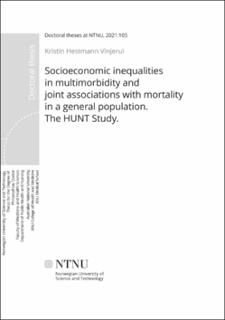| dc.contributor.advisor | Sund, Erik R | |
| dc.contributor.advisor | Douglas, Kirsty | |
| dc.contributor.advisor | Bjørngaard, Johan H | |
| dc.contributor.advisor | Krokstad, Steinar | |
| dc.contributor.author | Vinjerui, Kristin Hestmann | |
| dc.date.accessioned | 2021-03-29T11:45:06Z | |
| dc.date.available | 2021-03-29T11:45:06Z | |
| dc.date.issued | 2021 | |
| dc.identifier.isbn | 978-82-326-5844-2 | |
| dc.identifier.issn | 2703-8084 | |
| dc.identifier.uri | https://hdl.handle.net/11250/2735980 | |
| dc.description.abstract | Background: Multimorbidity, the concurrence of multiple chronic conditions, is highly frequent. Varying definitions and measures of multimorbidity hamper comparability of research, which is exemplified with wide ranges of prevalence estimates but a steady association with mortality.
The complexity in the treatment and burden of multimorbidity are associated with the combinations of conditions, presence of associated health concepts, such as frailty, personal factors, and social context, such as biology, lifestyle, and living conditions. Frailty is a dynamic measure of biological age, with impaired function (physical, psychological, or social) and increased risk of adverse events including death. Social health inequalities, in which the burden of poor health and premature death is higher with lower socioeconomic position, is well-known worldwide, and multimorbidity is no exception, in that it occurs at higher rates at younger ages, and with more complex combinations of conditions in socioeconomically deprived groups.
There are few studies on complex measures of multimorbidity, suggested to detect those with increased care needs and severity and their association with socioeconomic position; there is also a research gap on the joint association of socioeconomic position and multimorbidity with mortality. Thus, the aims of this thesis are to describe the socioeconomic distribution of complex measures of multimorbidity (article I, article II, and supplemental analysis on writing this dissertation) and how socioeconomic position may modify the association of multimorbidity with mortality (article III) in an adult general population. Examining several multimorbidity measures in the same cohort makes possible a unique direct comparison of socioeconomic gradients in prevalence and joint associations with mortality.
Methods: The total county health survey Trøndelag Health Study 2006-2008 (HUNT3) provided data on chronic conditions, impairments, and mortality (until February 1, 2019), as well as socioeconomic position. Several multimorbidity measures were explored based on individual and organ system group counts and the presence of frailty. Socioeconomic differences in prevalence were explored cross-sectionally, and joint association with mortality were explored prospectively.
Results: The overall prevalence varied by the complex measure of multimorbidity from 18% to 63%. All multimorbidity measures were more prevalent in the lower socioeconomic groups, in women, and with increased age but were common across age groups in both sexes. Socioeconomic inequalities in prevalence varied by sex and age but persisted from young adulthood to old age. Mortality increased by the number of conditions with varying but intact socioeconomic gradients, and relative mortality risk increased with the presence of multimorbidity and lower socioeconomic position.
Conclusions: Even complex measures of multimorbidity were common in the general population, with socioeconomic inequalities in prevalence throughout adulthood and socioeconomic inequalities in mortality across multimorbidity measures. The findings call for continuous public policy and public health to prevent socioeconomic inequalities in health. The magnitude of multimorbidity in all age groups suggest a demand for generalist and person-centered approaches that consider socioeconomic context in health care. In Norway, family doctors are in a unique position to offer continuous care, and this arrangement should be kept as a high priority. Future research on trajectories, associations with a variety of social determinants of health, health care utilization, and mortality would be relevant to enhance future prevention and management of multimorbidity. | |
| dc.language.iso | eng | en_US |
| dc.publisher | NTNU | en_US |
| dc.relation.ispartofseries | Doctoral theses at NTNU;2021:105 | |
| dc.relation.haspart | Paper 1:Vinjerui, Kristin Hestmann; Boeckxstaens, Pauline; Douglas, Kirsty A.; Sund, Erik. Prevalence of multimorbidity with frailty and associations with socioeconomic position in an adult population: findings from the cross-sectional HUNT Study in Norway. BMJ Open 2020 ;Volum 10.(6)
http://dx.doi.org/10.1136/bmjopen-2019-035070
This is an open access article distributed in accordance with the Creative Commons Attribution Non Commercial (CC BY-NC 4.0) | en_US |
| dc.relation.haspart | Paper 2:
Vinjerui, Kristin Hestmann; Bjerkeset, Ottar; Bjørngaard, Johan Håkon; Krokstad, Steinar; Douglas, Kirsty A.; Sund, Erik.
Socioeconomic inequalities in the prevalence of complex multimorbidity in a Norwegian population: findings from the cross-sectional HUNT Study. BMJ Open 2020 ;Volum 10.(6)
http://dx.doi.org/10.1136/bmjopen-2020-036851
This is an open access article distributed in accordance with the Creative Commons Attribution Non Commercial (CC BY-NC 4.0) | en_US |
| dc.relation.haspart | Paper 3:
Vinjerui, Kristin Hestmann; Bjørngaard, Johan Håkon; Krokstad, Steinar; Douglas, Kirsty A.; Sund, Erik.
Socioeconomic position, multimorbidity and mortality in a population cohort, the HUNT Study. Journal of Clinical Medicine 2020 ;Volum 9.(9)
https://doi.org/10.3390/jcm9092759
This is an open access article distributed under the Creative Commons Attribution License (CC BY 4.0) | en_US |
| dc.title | Socioeconomic inequalities in multimorbidity and joint associations with mortality in a general population. The HUNT Study. | en_US |
| dc.type | Doctoral thesis | en_US |
| dc.subject.nsi | VDP::Medical disciplines: 700::Health sciences: 800 | en_US |
